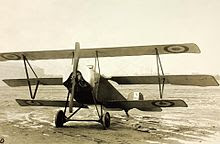In January 1914, designer Gustave Delage joined the Société Anonyme des Etablissements Nieuport, and started working on a series of aircraft that would remain in production for the remainder of the First World War.
The Nieuport 10 was first of these and was originally designed to compete in the Gordon Bennett Trophy race of 1914. World War I caused this contest to be cancelled, and the type was developed as a military two seat reconnaissance aircraft that entered service in 1915.
The type featured a distinctive "V" strut layout. The lower wing was much smaller in area than the upper wing, and the concept was intended to combine the strength of the biplane's wire braced wing cell with the good visibility of the parasol monoplane.
Many were converted or built as single-seat fighters by covering the front cockpit, and adding a Lewis Gun or Vickers machine gun either to fire through the center section of the top wing or mounted over it, firing forwards. In this form, the type was used as a fighter.
Two major types were developed from the Nieuport 10 - the Nieuport 11 Bébé - a smaller aircraft, designed from the outset as a single-seater, and the Nieuport 12 - a more powerful two-seater with a larger top wing. In addition, production was undertaken of a dedicated trainer version under the Nieuport 83 E.2 designation with detail changes. A single example of a triplane, using a Nieuport 10 airframe was built to test an unusual staggered wing concept.
Operators
- Belgian Air Force
- Brazilian Air Force
- Aéronautique Militaire
- Aéronavale
- Finnish Air Force (ex-Russian examples)
- Kingdom of Italy
- Corpo Aeronautico Militare
- Imperial Japanese Army Air Service
- Russian Empire
- Imperial Russian Air Service - imported large numbers and built under licence.
- Imperial Russian Navy - ex Air Service aircraft.
- Serbian Air Force
- Royal Thai Air Force
- Ukrainian People's Army (One aircraft only)
- Royal Naval Air Service - early user.
- United States Air Service of the American Expeditionary Force
- Soviet Union
- Workers' and Peasants' Air Fleet (ex-Russian examples)
Two Nieuport-Macchi 10,000's survive in Italy, one at the Museo Storico Italiano della Guerra and one at the Museo della Scienza e della Tecnologia "Leonardo da Vinci" and one original Nieuport 83 E.2, flown by Charles Nungesser while barnstorming, is at Old Rhinebeck Aerodrome on static display.
Crew: one, pilot
Length: 7.09 m
Wingspan: 8.20 m
Height: 2.7 m
Wing area: 18 m²
Empty weight: 411 kg
Loaded weight: 658 kg
Powerplant: 1 × le Rhône 9C rotary, 60 kW / 80 hp
Maximum speed: 139 km/h
Range: 249.44 kilometers
Service ceiling: 4,572 m
Rate of climb: 2.1 m/s
Endurance: 2.5 hours
Armament: 1 × Lewis machine gun mounted atop the upper wing







Love this kind of planes...
VastaaPoistaLove this kind of planes...
VastaaPoista